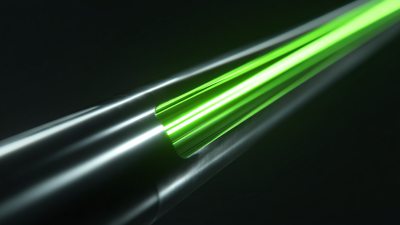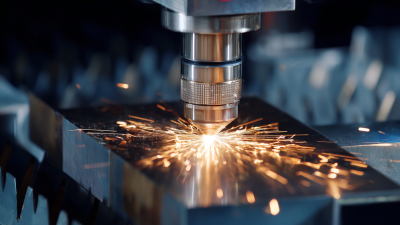Exploring the Future: How Laser Machines Are Revolutionizing Modern Manufacturing Techniques
The manufacturing landscape is undergoing a significant transformation, largely driven by the advancements in technology and the incorporation of laser machines. According to a report by MarketsandMarkets, the global laser processing market is projected to grow from $6.5 billion in 2020 to $9.2 billion by 2025, showcasing a robust compound annual growth rate (CAGR) of 7.3%. This remarkable growth indicates not only the increasing adoption of laser technology in manufacturing processes but also highlights its pivotal role in improving efficiency, precision, and product quality.
Experts like Dr. Emma Reynolds, a renowned authority in the field of laser technology, have emphasized the importance of laser machines in modern manufacturing. She stated, “Laser machines are not just tools; they are catalysts for innovation, enabling manufacturers to achieve levels of precision and automation that were previously unimaginable.” As industries strive to meet the demands of customization, laser machines provide unparalleled flexibility, allowing for intricate designs and quick adaptations in production lines.
As we explore the future of manufacturing, it becomes evident that laser machines will be at the forefront of this evolution. Their ability to enhance productivity while reducing waste and operational costs will be crucial in maintaining competitive advantages in an ever-evolving market. Therefore, understanding the impact of laser technology on manufacturing not only reveals current trends but also sets the stage for future innovations.

How to Understand the Principles Behind Laser Technology in Manufacturing
Laser technology is rapidly changing the landscape of modern manufacturing, primarily by enhancing precision and efficiency. Understanding the principles behind laser technology is essential for grasping its transformative potential. Lasers operate by concentrating light into a coherent, focused beam, which can be used for a variety of applications including cutting, welding, and additive manufacturing. This technology ensures that processes such as laser powder bed fusion are executed with high accuracy, allowing for intricate designs in both metals and polymers while minimizing waste.
At the forefront of innovation, recent advances in laser scanning and monitoring technologies are enabling manufacturers to achieve superior quality in metal fabrication. For instance, the utilization of high-quality 3D laser scanners improves accuracy in the manufacturing process, ensuring that even the most complex components can be crafted with precision. Additionally, the implementation of laser welding process monitors is vital in maintaining consistent weld quality, particularly in industries where safety is paramount. As production demands evolve, mastering laser technology becomes increasingly critical for manufacturing entities aiming to stay competitive in a rapidly changing market.
How to Choose the Right Laser Machine for Your Specific Manufacturing Needs
When selecting the right laser machine for specific manufacturing needs, it's essential to consider various factors to ensure optimal performance and cost-efficiency. The laser cleaning technology, for instance, has gained traction in recent years, with the market expected to grow significantly as industries recognize the benefits of this innovative method. Research indicates that the global laser cleaning market is evolving, driven by the increasing demand for eco-friendly cleaning solutions across sectors such as aerospace, automotive, and manufacturing.
**Tips:** Identify the specific applications you need the laser machine for, such as metal cutting or cleaning. Look for machines that offer versatility and customizable options to adapt to different manufacturing scenarios.
Additionally, understanding the varying types of laser technology is crucial. Non-metal laser engraving machines are projected to reach a market size of $5.759 billion by 2032, showcasing a compound annual growth rate of 6.1%. This growth reflects the rising interest in precision manufacturing techniques and the need for high-quality outputs. Choose machines that align with the forecasted trends in your industry to stay competitive.
**Tips:** Evaluate the performance specs such as power output, speed, and precision. Investing in machines with advanced features can maximize efficiency and reduce downtime in manufacturing processes.
Exploring the Future: How Laser Machines Are Revolutionizing Modern Manufacturing Techniques - How to Choose the Right Laser Machine for Your Specific Manufacturing Needs
| Laser Type | Cutting Thickness (mm) | Material Compatibility | Power (W) | Typical Applications |
|---|---|---|---|---|
| CO2 Laser | 1-25 | Wood, Acrylic, Glass | 40-400 | Signage, Cut-outs, Engravings |
| Fiber Laser | 1-10 | Metals, Plastics | 100-6000 | Sheet Metal, Tubes, Parts |
| Nd:YAG Laser | 0.5-25 | Metals, Ceramics | 10-300 | Welding, Marking, Engraving |
| Ultrafast Laser | <1 | Metals, Plastics, Glass | 1-100 | Micromachining, Medical Devices |
| Laser Engraver | <5 | Wood, Glass, Leather | 30-150 | Personalized Gifts, Crafts |
How to Implement Laser Machines into Your Existing Production Line Efficiently
Implementing laser machines into existing production lines can significantly enhance efficiency and precision in manufacturing processes. To begin, it is crucial to evaluate the current setup and identify areas where laser cutting, engraving, or welding can replace traditional methods. Conducting a thorough analysis of workflow, materials, and output goals will help pinpoint the best applications for laser technology, ensuring that the integration complements existing operations rather than disrupts them.
Once potential laser applications are identified, the next step is to engage with experienced suppliers who can provide guidance on integrating the technology. Collaborating with experts allows manufacturers to customize laser systems that fit seamlessly into their production line. Additionally, training staff is essential to maximize the benefits of laser technology. Well-versed operators can leverage the precision of lasers to increase productivity, minimize waste, and improve the overall quality of the products. By carefully planning the integration process and focusing on training, manufacturers can ensure a smooth transition to laser technology, revolutionizing their production techniques and maintaining competitive advantages in the market.
How to Optimize Material Utilization with Laser Cutting Techniques
Laser cutting techniques are rapidly transforming the landscape of material utilization in modern manufacturing. By employing high-intensity laser beams, these machines perform various operations such as cutting, welding, and surface treatment with incredible precision and efficiency. The global market for laser cutting machines is projected to grow from $6.85 billion in 2025 to $14.14 billion by 2032, reflecting an annual growth rate of 10.9%. This surge underscores the increasing reliance on laser technologies to enhance productivity and material efficiency across industries.
To optimize material utilization, manufacturers should consider implementing Bayesian optimization techniques that empower ultra-precise laser processing. This approach not only helps in maximizing the yield from raw materials but also reduces waste significantly. For instance, when cutting valuable silicon carbide wafers, even a second of processing time can impact profitability. Therefore, integrating advanced laser cutting solutions that focus on speed and accuracy can lead to improved operational efficiency.
Tips: Always ensure that your laser settings are tailored to the material you are using to achieve optimal cuts. Regular maintenance and calibration of the laser machine are crucial to maintain high performance. Additionally, analyzing cut patterns and adjusting accordingly can greatly enhance material utilization, helping your business stay competitive in the market.
How to Maintain and Troubleshoot Laser Machines for Longevity and Performance
Maintaining laser machines is crucial for ensuring their longevity and optimal performance in modern manufacturing. Regular maintenance routines, such as cleaning optical components and aligning the laser beam, can significantly enhance the efficiency and precision of the machine. Dust and debris on lenses and mirrors can impede the laser’s focus, leading to inconsistent cutting or engraving results. Therefore, operators should implement a schedule for routine checks to keep these parts clean and properly aligned.
Troubleshooting issues promptly is equally important. Common problems include inconsistent power output, misalignment, and cooling system failures. Operators should be trained to recognize warning signs, such as unusual noises or error messages, that may indicate larger underlying issues. Implementing a systematic approach for diagnostics, such as using software tools or referring to the machine’s manual, can help in quickly identifying and resolving issues before they escalate into costly repairs or downtime. By prioritizing maintenance and effective troubleshooting, manufacturers can ensure that laser machines continue to perform reliably and contribute to the industry’s advancements.
Machine models and specifications are subject to change without notice.




